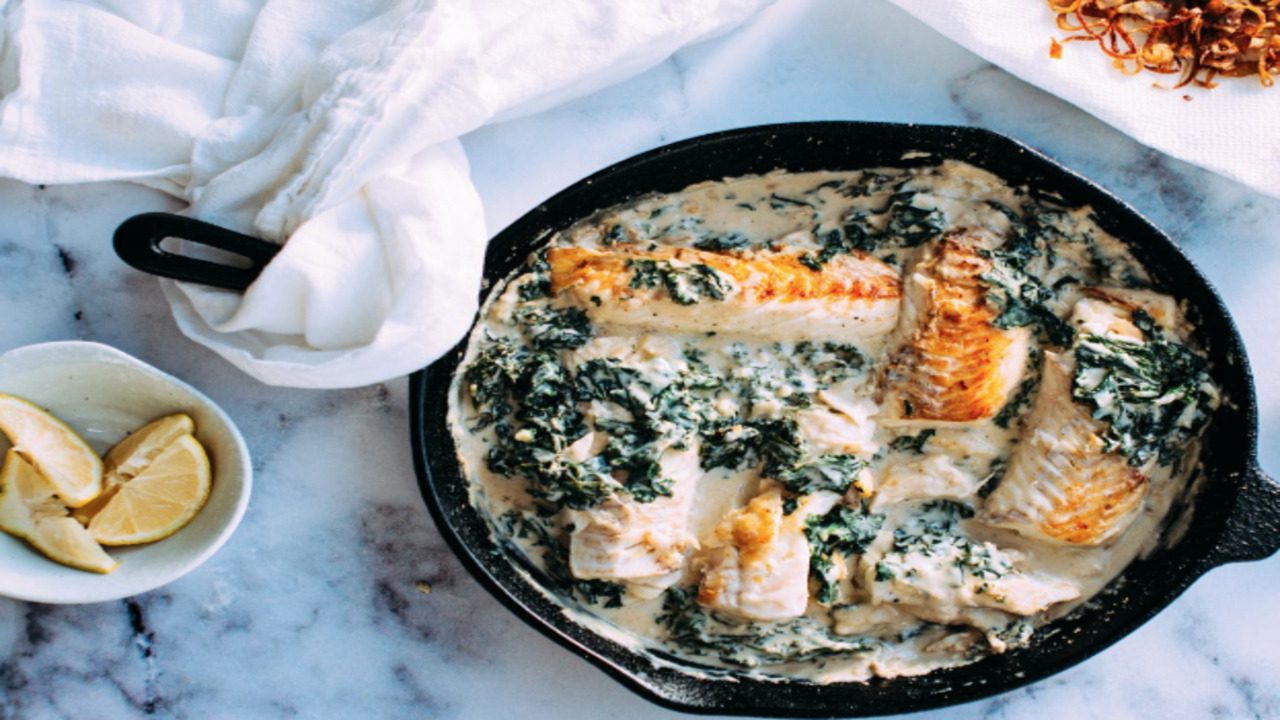Also known as white sauce, béchamel is one of the five mother sauces of French cuisine. It is Versatile, tasty, and easy to prepare, and enriches myriad culinary preparations. Also, it is a protagonist of other sauces that we call derivative sauces.
Achieving the perfection of a sauce is just one of the many challenges in the kitchen. However, to master them, it is necessary to practice countless times, which leads to the desired result.
-Paulo Daumas – WRITER AND FOOD AND WINE SPECIALIST
Learn how to master this creamy and velvety sauce that you can incorporate into many dishes.
Jump To Section
- The Origin Of Béchamel Sauce
- 8 Essential Tips For Making A Perfect Béchamel Sauce
- Classic Dishes With Béchamel And Its Derivative Sauces
- Béchamel And Its Derivative Sauces
- Béchamel Sauce: The Classic French Recipe
The Origin Of Béchamel Sauce
It is thought that there are three theories on the origin of Bechamel Sauces:



First, the béchamel would have originated in Italy and was later introduced in France by the Italian noble Catherine de Médici (1519-1589).
The second was Louis de Béchameil (1603-1703), a French financier who made his fortune during the French Civil War and later became chief steward of King Louis XIV. Louis de Béchameil claimed to have invented the Béchamel sauce when he improved a sauce made from cream, initially created by François Pierre de la Varenne (1615-1678).
The third was François Pierre de la Varenne (1615-1678), a foremost member of a group of French chefs who also claimed to have created the bechamel sauce when he was a Court chef during King Louis XIV’s reign. He dedicated the name “Béchamel” as a compliment to Louis de Béchameil as they worked simultaneously in Louis XIV’s court.
Despite the fact about the sauce history, we know Marie-Antoine Carême (1784 – 1833) and Auguste Escoffier (1846 – 1935) organized and refined the mother sauces of French cuisine into five categories. One of their béchamel sauces has been prepared until today.
8 Essential Tips For Making A Perfect Béchamel Sauce
Achieving the perfection of a sauce is just one of the many challenges in the kitchen. However, to master them, it is necessary to practice countless times, which leads to the desired result.
Mise en Place
Mise en place is a French culinary term that means “to put everything in place.” In practice, it is an essential step before preparing any recipe. You will organize the kitchen utensils and portion the ingredients in advance, avoiding mistakes during preparation. Therefore, get everything organized and portioned before preparing the Béchamel sauce.
Get rid of residues
Remember that Béchamel is white in color, revealing any dirty presence in the sauce. Any presence of residues can reflect and ruin the flavor and appearance of the sauce. So keep pots and pans clean.
No lumps
When incorporating the roux into the sauce béchamel, avoid flour lumps by mixing a small amount of the roux with the milk first, allowing time for the ingredients to be incorporated evenly. Then mix in the rest. In the final step, pass the sauce through a fine sieve so that no undercooked flour granules end on the plate.
Avoid burning the sauce
White sauces burn easily, so prefer a stainless steel double-bottom pot and gently cook over medium to low heat. Also, use a wooden spoon or plastic spatula to scrape the pan’s bottom and sides, as the milk solids tend to stick and burn.
The right roux
The different roux stages (white, blond, brown, and dark brown) correspond directly to the final color of the sauce. Béchamel sauce requires a blanc roux that cooks for about 2-3 minutes over low heat until it eliminates the raw flour flavor.
Nappé Consistency
In French cuisine, nappé is used for a sauce’s creamy and dense texture. To check if it has reached the right point, dip a spoon in the preparation, and when you run your finger along the back of the spoon, the “trail” formed by the finger has to remain, indicating that the Béchamel sauce is ready.
Flavor
Some aromatics and spices, such as fresh thyme and black pepper, overlap and mask the final flavor. Use them in the last minutes of the cooking process as the recipe calls.
Strain the sauce
Strain the sauce to obtain a homogeneous texture, besides avoiding residues that form on the pan’s bottom and sides.
Skin layer
If you intend to serve the sauce later, place a piece of plastic wrap directly on the surface to prevent skin from forming.
Classic Dishes With Béchamel And Its Derivative Sauces

As a versatile white sauce, béchamel plays its creamy effect when incorporated into a variety of dishes, such as:
- Croque Monsieur
- Lasagne Bolognese
- Cheese Soufflé
- Gnocchi `A La Parisienne
- Medium Cooked Eggs With Spinach
- Stuffed Crab Thermidor
- Pike Dumplings With Lobster Sauce
Béchamel And Its Derivative Sauces
Béchamel Sauce: The Classic French Recipe
Learn now step by step the classic French recipe for Béchamel sauce – simple, versatile, and tasty.
Now, get to work! 😋

Béchamel
Equipment
- Sieve or chinoy
- Whisk
- Double-bottom saucepan
- Spatula
Ingredients
- 60 g Flour
- 60 g Butter
- 1 liter Milk
- 1 pc Onion – halved
- 2 pcs Cloves
- 1 pc Bay leaf
- 1 pc Bouquet garni
- Salt to taste
- White pepper to taste
- Nutmeg to taste
Instructions
Mise en place
- Onion pique: Peel the onion. Then, cut it in half and trim off the root end. Attach 1 bay leaf to the cut-side of the onion using the cloves as pins.Bouquet garni: Parsley stalks, 1 bay leaf, 1 celery stalk, wrapped in a green leek leaf, tied with culinary string.
Roux preparation
- Melt the butter in a small saucepan over medium heat. When the butter begins to foam, add the flour and cook for 3mins. Set aside to cool.
Sauce preparation
- In a separate saucepan, heat the milk with the onion studded with cloves and bay leaf until it is just about to boil, and let it infuse for 30 minutes.
- Temper the roux with a little warm milk. Then, add to the rest of the milk.
- Add the bouquet garni and season with salt, white pepper, and nutmeg. Cook over medium heat until it reaches the nappé consistence.
- Strain through a fine sieve or chinoy into a clean pan. Serve or reserve in a bain-marie.
Notes
Did you make this recipe?
Please let me know how it turned out for you! Leave a comment below and share our content.
Please help our community grow by following our social media on Spotify, Instagram, Facebook, Youtube, and Tiktok, and stay up to date with the news from the world of Gastronomy.
Don’t forget to tag @gastrovinoacademy on Instagram and hashtag it #gastrovinoacademy.
Cheers🍷



An interesting discussion is definitely worth comment. I do think that you need to publish more about this subject matter, it might not be a taboo subject but usually people do not speak about such topics. To the next! Cheers!!